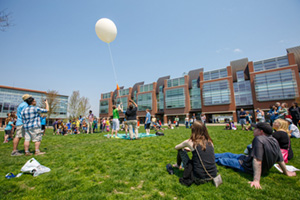Ontario Tech Physics sends weather balloon to the edge of space
 The video is breathtaking – a perspective of Durham Region and Northumberland County unlike anything you’ve seen before. The Ontario Tech University's (Ontario Tech) Faculty of Science is sharing some fascinating aerial images of Oshawa and beyond that were captured on May 9.
The video is breathtaking – a perspective of Durham Region and Northumberland County unlike anything you’ve seen before. The Ontario Tech University's (Ontario Tech) Faculty of Science is sharing some fascinating aerial images of Oshawa and beyond that were captured on May 9.
The Physics Research Group launched a helium-filled weather balloon (diameter: 2.5 metres, mass: 650 grams) to the edge of space, carrying with it a payload of atmospheric sensors, a 1080p video camera, a global positioning system (GPS) tracker and a parachute.
“During a similar launch in late April our batteries lasted only 30 minutes into the flight, so we were keen to try again,” said Dr. Rupinder Brar, Senior Physics Lecturer. “We decided to launch it as part of this year’s Science Rendezvous event on campus, to demonstrate cool science in-action for a large audience of children and parents.”
The experiment is Ontario Tech's contribution to the 2015 Canada-wide High Altitude Balloon Experiment (HABEX). HABEX is connected to the Global Space Balloon Challenge (GSBC) which challenged people from around the world to simultaneously fly high-altitude balloons from every corner of the globe. Nearly 300 teams from 47 countries registered to fly balloons.
The national office of Science Rendezvous covered 80 per cent of the cost of each Canadian university balloon experiment.
One hour prior to the May 9 launch, Transport Canada was notified, and clearance was granted by authorities at the Oshawa Airport.
Thanks to a new strategy to protect the batteries from the sub -40°C temperatures of the lower stratosphere, the second balloon launch was much more successful.
“For this launch, we used a triple-capacity battery, and included ‘hot-pocket’ hand warmers to keep the batteries at a working temperature,” said team member Kyle Mills, a Ontario Tech Bachelor of Science (Physics) graduate who is now working on his Master of Science (Materials Science) degree at Ontario Tech. “We also insulated the payload container with styrofoam.”
The payload was a medium-sized snap-lid food container with the camera positioned to look outward toward the horizon. The sensors to measure atmospheric conditions were mounted externally. The GPS sensors, batteries and circuitry were contained inside the unit.
Ascent video (watch the video of the first few minutes of ascent, as seen by the payload camera)
Launch visualization (simulated video show direction of travel in the first few minutes of the flight)
The balloon ascended more quickly than anticipated, averaging 4.4 metres per second, likely a result of overfilling the balloon with helium. The blue ‘sky’ is seen as a tiny strip above the earth on the horizon, separating our planet from the black of space.
"It's amazing to think that our balloon literally went higher than the sky,” said Mills. “I've seen pictures and video like this before, but being involved and actually observing it myself makes it seem so much more awesome."
After rising for nearly two hours to an altitude of more than 25,000 metres (25 kilometres) the balloon expanded against the extremely low pressure of the stratosphere and eventually burst.
Peak altitude and burst (watch the balloon burst at peak altitude)
The parachute deployed and the payload began a 40-minute descent back to the ground. It landed just east of Cobourg, Ontario, about 66 kilometres away from the launch site in Polonsky Commons. The recovered payload will put on display in the Ontario Tech Science Building (Physics Lab, Room 1620).
“The data collected during the balloon experiment will be built into our first-year and second-year Physics curriculum, where we look at problems such as freefall and terminal velocity,” said Dr. Isaac Tamblyn, Assistant Professor of Physics. “In future years we will conduct launches with a Raspberry Pi – a small computer used for data collection, simulation and analysis. We are using them throughout our undergraduate Physics program to help students develop skills in automated data collection and analysis.”
Ontario Tech space balloon team:
- Dr. Rupinder Brar, Senior Lecturer, Physics and Astronomy
- Angella MacEwen, volunteer
- Dr. Joseph MacMillan, Senior Lecturer, Physics and Astronomy
- Amber Maharaj, graduate student
- Brady Metherall, undergraduate student
- Kyle Mills, graduate student
- Austin Nehring, graduate student
- Solomon Onyeama-asonye, undergraduate student
- Anna Tamblyn, volunteer
- Dr. Isaac Tamblyn, Assistant Professor, Physics
